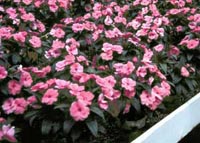Resource Library
Plant of the Week: New Guinea Impatiens
The University of Arkansas System Division of Agriculture does not promote, support or recommend plants featured in "Plant of the Week." Please consult your local Extension office for plants suitable for your region.
Plant of the Week
New Guinea Impatiens
Latin: Impatiens x New Guinea

The government takes a lot of bashing for the way our tax money is spent, but sometimes
the people who work in Washington get it right.
Few would have guessed that when USDA plant collectors Harold Winters and J. J. Higgins,
on a trip jointly sponsored by the government and Longwood Gardens in Pennsylvania,
flew to the remote Southern Pacific nation of New Guinea to collect a few wildflowers
in 1970, they would be adding fuel to our nation’s economic engine.
They succeeded in introducing over a dozen different species of impatiens which were
used to create the hybrids that we enjoy in our gardens today. At the time all impatiens
sales only amounted to about $3 million, but today the wholesale value of just New
Guinea Impatiens is more than $50 million per year. Not a bad return on what was probably
an investment of less than $25,000.
The original New Guinea Impatiens were more upright growing than regular impatiens
with larger leaves and flowers. The foliage is a bright green, sometimes variegated
or shaded with purplish pigments.
Most modern hybrids produce branches freely and form compact balls covered with flowers.
The flowers are often deeply pigmented with intense shades of red and orange, plus
selections with more muted shades of pink and white. Blooms are 2 inches across with
the long nectary spur extending behind the flower.
Much of the breeding work on the modern New Guinea Impatiens has been carried out
by the Kientzler greenhouse company in Gensingen, Germany. They have been introducing
a steady string of vegetatively propagated plants since the early 1980's and now offer
over 50 selections. Their Paradise Series is the largest growing group, with plants
routinely growing to 16 inches tall and wide by the end of the summer. Their Nino
Series is faster to flower and only about 12 inches tall. In the early 1990s, seed
grown in New Guinea were introduced. Big improvements in seed grown-New Guinea hybrids
are expected over the next few years.
Because they are relatively pricey, New Guinea Impatiens are most often encountered
in hanging baskets and containers, but they are equally suited for growing in the
flower bed. As a group, the New Guinea hybrids will tolerate more sun than the more
common sultanas, but they still should not have full sun.
If plants are container grown, fertilize every two weeks with a water soluble fertilizer
as recommended on the container. In the ground, plant New Guinea Impatiens in a site
that has had some organic matter worked into the soil. Don’t let the plants wilt,
but on the other hand, avoid overwatering which can cause root rot. With only minimal
care, New Guinea Impatiens will reward your efforts with season-long blooms and bragging
rights for the best garden on the block.
By: Gerald Klingaman, retired
Extension Horticulturist - Ornamentals
Extension News - April 30, 1999
The University of Arkansas System Division of Agriculture does not maintain lists of retail outlets where these plants can be purchased. Please check your local nursery or other retail outlets to ask about the availability of these plants for your growing area.